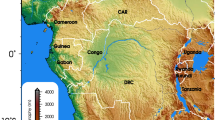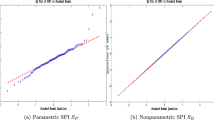Abstract
The Standardised Precipitation and Evapotranspiration Index (SPEI) became one of the popular drought indices in the context of increasing temperatures under global warming in recent periods. The SPEI is estimated by fitting a probability distribution for the difference between precipitation (P) and potential evapotranspiration (PET), which represents the climatic water balance. The choice of an inappropriate probability distribution may lead to bias in the index values leading to distorted drought severity. Till date, none of the studies have focused on the suitability of the probability distribution for SPEI over India. The objective of the present study is to compare and evaluate the performance of a group of candidate probability distributions over seven meteorologically homogeneous zones and all over India using high resolution (0.25°) gridded daily precipitation data from India Meteorological Department (IMD). The Kolmogorov–Smirnov (K–S) test was used to test the goodness-of-fit for (P–PET) and Akaike Information Criterion (AIC) was used to obtain the relative distribution rankings for each grid point. The results of the study suggest that Pearson type III distribution has performed better than other distributions, significantly for shorter time scales and slightly for longer time scales, for each meteorological homogeneous zone based on K–S test. Also, for shorter time scales, Pearson type III distribution has been observed to be significantly better based on AIC with 82.89% and 71.91% grid points for 3 and 6 months, respectively. However, the relative ranking by AIC revealed GEV distribution as the best fit for SPEI values all over India for longer time scales with total grid points as 50.26%, and 58.81% for 12- and 24-month time scales respectively. Pearson type III distribution for shorter time scales (3 and 6 months) and GEV distribution for longer time scales (12 and 24 months) have been identified as the best distributions for fitting SPEI for Indian case study. Comparison of GEV based SPEI with remote sensing-based drought severity index (DSI) for drought events indicated concordance for most of regions in India. Also, SPEI is evaluated to test its capability to represent seasonality and its performance has been compared with Standardised Precipitation Anomaly Index (SPAI) which is known to represent seasonality well.












Similar content being viewed by others
References
Aadhar S and Mishra V 2017 High-resolution near real-time drought monitoring in South Asia; Sci. Data 4 170145.
Akaike H 1974 A new look at the statistical model identification; IEEE T. Automat. Contr. 19(6) 716–723.
Alam N M, Raizada A, Jana C, Meshram R K and Sharma N K 2015 Statistical modeling of extreme drought occurrence in Bellary District of Eastern Karnataka; Proc. Nat. Acad. Sci. India B. 85(2) 423–430.
Alam N M, Sharma G C, Moreira E, Jana C, Mishra P K, Sharma N K and Mandal D 2017 Evaluation of drought using SPEI drought class transitions and log-linear models for different agro-ecological regions of India; Phys. Chem. Earth Parts A/B/C 100 31–43.
Allen R G, Pereira L S, Howell T A and Jensen M E 2011 Evapotranspiration information reporting: I. Factors governing measurement accuracy; Agr. Water Manag. 98(6) 899–920.
Bhalme H N and Mooley D A 1980 Large-scale droughts/floods and monsoon circulation; Mon. Weather Rev. 108(8) 1197–1211.
Bordi I, Fraedrich K, Jiang J M and Sutera A 2004 Spatio-temporal variability of dry and wet periods in eastern China; Theor. Appl. Climatol. 79(1–2) 81–91.
Chakravarty I M, Roy J D and Laha R G 1967 Handbook of methods of applied statistics.
Dai A 2011 Characteristics and trends in various forms of the Palmer Drought Severity Index during 1900–2008; J. Geophys. Res. Atmos. 116(D12).
Chanda K and Rajib Maity 2015 Meteorological Drought Quantification with Standardized Precipitation Anomaly Index (SPAI) for the Regions with Strongly Seasonal and Periodic Precipitation; J. Hydrol. Eng., American Society for Civil Engineering (ASCE) 20(12) 06015007-1–06015007-8, https://doi.org/10.1061/(asce)he.1943-5584.0001236.
Chavan S R and Srinivas V V 2017 Regionalization based envelope curves for PMP estimation by Hershfield method; Int. J. Climatol. 37(10) 3767–3779.
Doorenbos J and Pruitt W O 1977 Background and development of methods to predict reference crop evapotranspiration (ETo); Crop Water Requirements. FAO Irrigation and Drainage Paper 24 108–119.
Ghosh S and Mujumdar P P 2007 Nonparametric methods for modeling GCM and scenario uncertainty in drought assessment; Water Resour. Res. 43(7).
Goswami B N, Venugopal V, Sengupta D, Madhusoodanan M S and Xavier P K 2006 Increasing trend of extreme rain events over India in a warming environment; Science 314(5804) 1442–1445.
Guhathakurta P 2003 Droughts in districts of India during the recent all India normal monsoon years and its probability of occurrence; Mausam 54(2) 542–544.
Hargreaves G H 1975 Moisture availability and crop production; T. ASAE 18(5) 980–984.
Hargreaves G H and Samani Z A 1982 Estimating potential evapotranspiration; J. Irr. Drain Div-asce 108(3) 225–230.
Hargreaves G H and Samani Z A 1985 Reference crop evapotranspiration from temperature; Appl. Eng. Agric. 1(2) 96–99.
Homdee T, Pongput K and Kanae S 2016 A comparative performance analysis of three standardized climatic drought indices in the Chi River basin, Thailand; Agr. Nat. Resour. 50(3) 211–219.
Ив aнoв (Ivanov) HH (1954) Oб oпpeдeлeнии вeличин иcпapяeмocти. (About determination of evapotranspiration); Извecтия Bcec Гeoгp Oбщecтвa T 86(2) 189–195.
Jensen M E, Burman R D and Allen R G (eds) 1990 Evapotranpiration and irrigation water requirements. ASCE Manuals and Reports on Engineering Practices, No. 70.
Kumar K N, Rajeevan M, Pai D S, Srivastava A K and Preethi B 2013 On the observed variability of monsoon droughts over India; Weather Clim. Extremes 1 42–50.
Liu Y, Zhu Y, Ren L, Singh V P, Yang X and Yuan F 2017 A multiscalar Palmer drought severity index; Geophys. Res. Lett. 44(13) 6850–6858.
Mallya G, Mishra V, Niyogi D, Tripathi S and Govindaraju R S 2016 Trends and variability of droughts over the Indian monsoon region; Weather Clim. Extremes 12 43–68.
McKee T B, Doesken N J and Kleist J 1993 The relationship of drought frequency and duration to time scales; In: Proceedings of the 8th Conference on Applied Climatology, American Meteorological Society, Boston, MA, 17(22) 179–183.
Nath R, Nath D, Li Q, Chen W and Cui X 2017 Impact of drought on agriculture in the Indo-Gangetic Plain, India; Adv. Atmos. Sci. 34(3) 335–346.
Pai D S, Sridhar L, Guhathakurta P and Hatwar H R 2011 District-wide drought climatology of the southwest monsoon season over India based on standardized precipitation index (SPI); Nat. Hazards 59(3) 1797–1813.
Pai D S, Sridhar L, Rajeevan M, Sreejith O P, Satbhai N S and Mukhopadhyay B 2014 Development of a new high spatial resolution (0.25×0.25) long period (1901–2010) daily gridded rainfall data set over India and its comparison with existing data sets over the region; Mausam 65(1) 1–18.
Parthasarathy B, Rupa Kumar K and Munot A A 1996 Homogeneous regional summer monsoon rainfall over India: interannual variability and teleconnections; Indian Institute of Tropical Meteorology.
Penman H L 1948 Natural evaporation from open water, bare soil and grass; Proc. R. Soc. Lond. A 193(1032) 120–145.
Rajeevan M and Bhate J 2009 A high resolution daily gridded rainfall dataset (1971–2005) for mesoscale meteorological studies; Curr. Sci. 96(4) 558–562.
Rajeevan M, Gadgil S and Bhate J 2010 Active and break spells of the Indian summer monsoon; J. Earth Syst. Sci. 119(3) 229–247.
Rajeevan M, Bhate J and Jaswal A K 2008 Analysis of variability and trends of extreme rainfall events over India using 104 years of gridded daily rainfall data; Geophys. Res. Lett. 35(18).
Saikranthi K, Rao T N, Rajeevan M and Bhaskara Rao S V 2013 Identification and validation of homogeneous rainfall zones in India using correlation analysis; J. Hydrometeorol. 14(1) 304–317.
Shah R D and Mishra V 2015 Development of an experimental near-real-time drought monitor for India; J. Hydrometeorol. 16(1) 327–345.
Van der Schrier G, Jones P D and Briffa K R 2011 The sensitivity of the PDSI to the Thornthwaite and Penman‐Monteith parameterizations for potential evapotranspiration; J. Geophys. Res.-Atmos. 116(D3).
Sheng Y and Hashino M 2007 Probability distribution of annual, seasonal and monthly precipitation in Japan; Hydrol. Sci. J. 52(5) 863–877.
Shepard D 1968 A two-dimensional interpolation function for irregularly spaced data; Proc. 1968 ACM Nat. Conf., pp 517–524.
Sienz F, Bothe O and Fraedrich K 2012 Monitoring and quantifying future climate projections of dryness and wetness extremes: SPI bias; Hydrol. Earth Syst. Sci. 16(7) p. 2143.
Srivastava A K, Rajeevan M and Kshirsagar S R 2009 Development of a high resolution daily gridded temperature data set (1969–2005) for the Indian region. Atmos. Sci. Lett. 10(4) 249–254.
Stagge J H, Tallaksen L M, Gudmundsson L, Van Loon A F and Stahl K 2015 Candidate distributions for climatological drought indices (SPI and SPEI). Int. J. Climatol. 35(13) 4027–4040.
Stagge J H, Tallaksen L M, Gudmundsson L, Van Loon A F and Stahl K 2016 Response to comment on ‘candidate distributions for climatological drought indices (SPI and SPEI)’. Int. J. Climatol. 36(4) 2132–2138.
Stagge J H, Tallaksen L M, Xu C Y and Van Lanen H A J 2014 Standardized precipitation-evapotranspiration index (SPEI): Sensitivity to potential evapotranspiration model and parameters; IAHS Publ., pp. 367–373.
Thornthwaite C W 1948 An approach toward a rational classification of climate; Geogr. Rev. 38(1) 55–94.
Vicente-Serrano S M, Beguería S and López-Moreno J I 2010 A multiscalar drought index sensitive to global warming: The standardized precipitation evapotranspiration index; J. Clim. 23(7) 1696–1718.
Vicente-Serrano S M, Van der Schrier G, Beguería S, Azorin-Molina C and Lopez-Moreno J I 2015 Contribution of precipitation and reference evapotranspiration to drought indices under different climates; J. Hydrol. 526 42–54.
Vicente-Serrano S M and Beguería S 2016 Comment on ‘Candidate distributions for climatological drought indices (SPI and SPEI)’by James H Stagge et al., Int. J. Climatol. 36(4) 2120–2131.
Wang H, Chen Y, Y Pan, Chen Z and Ren Z 2019 Assessment of candidate distributions for SPI/SPEI and sensitivity of drought to climatic variables in China; Int. J. Climatol., https://doi.org/10.1002/joc.6081
World Meteorological Organization 2012 Standardized Precipitation Index User Guide, WMO-No. 1090, ISBN 978-92-63-11090-9.
Wu H, Svoboda M D, Hayes M J, Wilhite D A and Wen F 2007 Appropriate application of the (Anon., n.d.)standardized precipitation index in arid locations and dry seasons; Int. J. Climatol. 27(1) 65–79.
Acknowledgements
The research work presented in the manuscript is funded by Science and Engineering Research Board (SERB), Department of Science and Technology, Government of India through Start-up Grant for Young Scientists (YSS) Project no. YSS/2015/002111.
The authors sincerely thank the Editor and the anonymous reviewers for reviewing the manuscript and providing insightful comments.
Author information
Authors and Affiliations
Corresponding author
Additional information
Communicated by Rajib Maity
Rights and permissions
About this article
Cite this article
Monish, N.T., Rehana, S. Suitability of distributions for standard precipitation and evapotranspiration index over meteorologically homogeneous zones of India. J Earth Syst Sci 129, 25 (2020). https://doi.org/10.1007/s12040-019-1271-x
Received:
Revised:
Accepted:
Published:
DOI: https://doi.org/10.1007/s12040-019-1271-x




